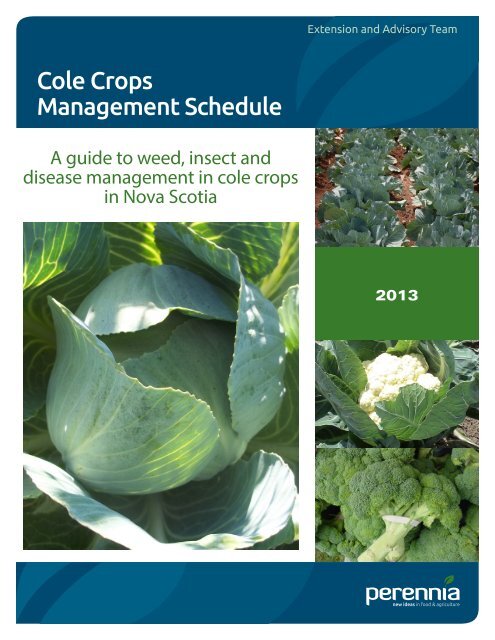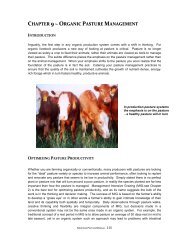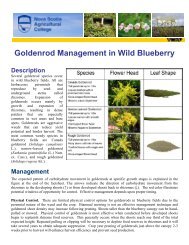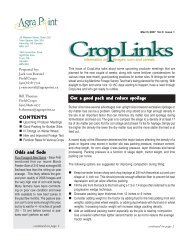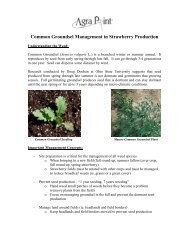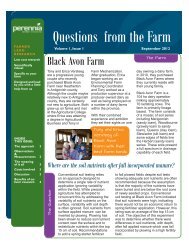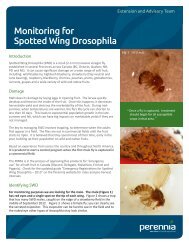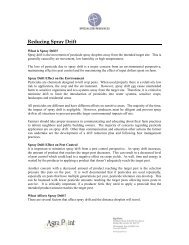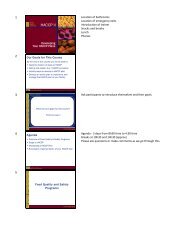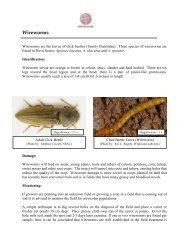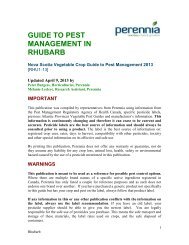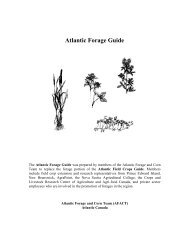Guide to Pest Management in Vegetable Crops - Perennia
Guide to Pest Management in Vegetable Crops - Perennia
Guide to Pest Management in Vegetable Crops - Perennia
Create successful ePaper yourself
Turn your PDF publications into a flip-book with our unique Google optimized e-Paper software.
Extension and Advisory Team<br />
Cole <strong>Crops</strong><br />
<strong>Management</strong> Schedule<br />
A guide <strong>to</strong> weed, <strong>in</strong>sect and<br />
disease management <strong>in</strong> cole crops<br />
<strong>in</strong> Nova Scotia<br />
2013
GUIDE TO PEST<br />
MANAGEMENT IN<br />
COLE CROPS<br />
Nova Scotia <strong>Vegetable</strong> Crop <strong>Guide</strong> <strong>to</strong> <strong>Pest</strong> <strong>Management</strong> 2013<br />
[COL2-13]<br />
Updated June 4, 2013 by<br />
Peter Burgess, Horticulture Specialist, <strong>Perennia</strong><br />
Mélanie Leclerc, Research Assistant, <strong>Perennia</strong><br />
IMPORTANT<br />
This publication was compiled by representatives from <strong>Perennia</strong> us<strong>in</strong>g <strong>in</strong>formation from the <strong>Pest</strong><br />
<strong>Management</strong> Regula<strong>to</strong>ry Agency of Health Canada, specific pesticide labels, previous Atlantic<br />
Prov<strong>in</strong>ces <strong>Vegetable</strong> <strong>Pest</strong> <strong>Guide</strong>s and manufacturer’s <strong>in</strong>formation. This <strong>in</strong>formation is<br />
cont<strong>in</strong>uously chang<strong>in</strong>g and therefore it can cease <strong>to</strong> be current and accurate. <strong>Pest</strong>icide<br />
labels are the best source of <strong>in</strong>formation and should always be consulted prior <strong>to</strong> us<strong>in</strong>g a<br />
product.<br />
By pr<strong>in</strong>t<strong>in</strong>g this publication, <strong>Perennia</strong> does not offer any warranty or guarantee, nor do they<br />
assume any liability for any crop loss, animal loss, health, safety or environmental hazard caused<br />
by the use of a pesticide mentioned <strong>in</strong> this publication.<br />
WARNINGS<br />
This publication is meant <strong>to</strong> be used as a reference for possible pest control options. Where<br />
there are multiple brand names of a specific active <strong>in</strong>gredient registered <strong>in</strong> Canada, <strong>Perennia</strong> has<br />
only listed a couple for reference purposes and as such does not endorse one brand over another.<br />
If you have purchased a generic product not specifically <strong>in</strong> this guide but has your crop and pest<br />
on the label, always follow that product label.<br />
If any <strong>in</strong>formation <strong>in</strong> this or any other publication conflicts with the <strong>in</strong>formation on the<br />
label, always use the label recommendation. You are legally responsible for the safe use of<br />
pesticides you purchase. This means the safe transport and s<strong>to</strong>rage of these materials, the label<br />
rates used on crops, and the safe disposal of conta<strong>in</strong>ers.<br />
Cole <strong>Crops</strong><br />
1
<strong>Pest</strong><br />
WEEDS:<br />
Preplant<br />
<strong>Perennia</strong>l weeds<br />
<strong>in</strong>clud<strong>in</strong>g<br />
quackgrass<br />
Group<br />
Active<br />
Ingredient<br />
<strong>Pest</strong>icide<br />
Product<br />
Name<br />
Rate<br />
Restricted-<br />
Entry<br />
Interval<br />
(REI)<br />
Pre-Harvest<br />
Interval<br />
(days)<br />
Remarks<br />
9 Glyphosate Roundup Orig<strong>in</strong>al 2.5-7.0 L/ha 12 hours 7 Apply <strong>in</strong> the fall or spr<strong>in</strong>g prior <strong>to</strong><br />
plant<strong>in</strong>g. Annual weed control<br />
programs will be necessary <strong>to</strong> control<br />
weeds germ<strong>in</strong>at<strong>in</strong>g after plant<strong>in</strong>g. For<br />
quackgrass control, apply <strong>to</strong> actively<br />
Roundup<br />
WeatherMAX<br />
Touchdown® 480<br />
1.67-8.0 L/ha<br />
2.5-7.0 L/ha<br />
Aim EC 36.5-117<br />
ml/ha<br />
grow<strong>in</strong>g quackgrass when at least 4<br />
new leaves are present. The low rate<br />
(2.5 L/ha) will provide a m<strong>in</strong>imum of<br />
one season control, while higher rates<br />
(4.75 <strong>to</strong> 7 L/ha) will provide longer<br />
term control. The low rate of Roundup<br />
should be applied <strong>in</strong> 50 <strong>to</strong> 100 L/ha<br />
water. If higher water volumes are<br />
used, add a suitable surfactant. Allow<br />
3 or more days after treatment before<br />
tillage. Best control of quackgrass is<br />
obta<strong>in</strong>ed when these herbicides are<br />
applied <strong>in</strong> the fall.<br />
- 1 Apply <strong>in</strong> m<strong>in</strong>imum spray volume of<br />
100 L/ha. Refer <strong>to</strong> label for target<br />
weeds, buffer zones and rates. Use<br />
high flow rate nozzles <strong>to</strong> apply the<br />
highest spray volume.<br />
Pre-Transplant 15 Dimethenamid Frontier 1.1-1.4 L/ha - 60 Transplanted Cabbage only. 11<br />
month rotational restriction for seed<strong>in</strong>g<br />
carrots or onions or transplant<strong>in</strong>g<br />
celery. Follow label for rate<br />
adjustments depend<strong>in</strong>g on soil texture<br />
and % organic matter.<br />
14 Carfentrazoneethyl<br />
Dimethenamid-<br />
P<br />
Frontier Max 756-963<br />
ml/ha<br />
24 hours 60 Apply prior <strong>to</strong> transplant<strong>in</strong>g and<br />
before weed emergence.<br />
Cole <strong>Crops</strong><br />
2
Preplant<br />
Incorporated<br />
Germ<strong>in</strong>at<strong>in</strong>g<br />
annual grasses<br />
and some<br />
broadleaf weeds<br />
Preemergence<br />
Treatments<br />
Germ<strong>in</strong>at<strong>in</strong>g<br />
grasses and<br />
some broadleaf<br />
weeds<br />
Stale seedbed<br />
technique<br />
Cole <strong>Crops</strong><br />
14 Oxyfluorfe Goal 2XL 1.13-2.0 L/ha 12 hours 60 days Applications must be made after<br />
completion of soil preparation, but<br />
prior <strong>to</strong> transplant<strong>in</strong>g. Use the lower<br />
rate for pre-emergence weed control on<br />
coarse texture soils with less that 1%<br />
organic matter. Use the highest rate for<br />
pre-emergence weed control on<br />
medium <strong>to</strong> f<strong>in</strong>e texture soils or soils<br />
conta<strong>in</strong><strong>in</strong>g greater that 1% organic<br />
matter. Apply <strong>in</strong> a m<strong>in</strong>imum of 200 L<br />
water/ha. Apply only one ground<br />
application per year. Only use for<br />
Broccoli, Cabbage and Cauliflower.<br />
3 Triflural<strong>in</strong> Treflan EC 1.7-3.0 L/ha 12 hours - Preplant <strong>in</strong>corporated <strong>in</strong> direct seeded<br />
cabbage and cauliflower or transplants<br />
Rival EC<br />
1.2-2.3 L/ha<br />
of cabbage, cauliflower, broccoli and<br />
Brussels sprouts. Incorporate with<strong>in</strong> 8<br />
Bonanza 400 1.5-2.75 L/ha<br />
hours of application follow<strong>in</strong>g label<br />
<strong>in</strong>structions. Ragweed and mustards<br />
are not controlled. Corn or cereal<br />
gra<strong>in</strong>s may be <strong>in</strong>jured when planted <strong>in</strong><br />
fields treated with triflural<strong>in</strong> the<br />
previous year. See label for rate<br />
accord<strong>in</strong>g <strong>to</strong> soil type.<br />
3 Chlorthal<br />
dimethyl<br />
Dacthal W-75 9.0-15.5<br />
Kg/ha<br />
15 Napropamide Devr<strong>in</strong>ol 50 DF 2.25-4.5<br />
Kg/ha<br />
- - Apply immediately after seed<strong>in</strong>g or<br />
directly over transplants but before<br />
weeds emerge. Ra<strong>in</strong>fall or irrigation is<br />
necessary for activity (m<strong>in</strong> 1 cm).<br />
Ragweed, nutsedge, smartweed and<br />
mustards are not controlled.<br />
- 60 Apply <strong>to</strong> direct seeded and<br />
transplanted cabbage, cauliflower and<br />
broccoli only.<br />
S-me<strong>to</strong>lachlor Dual II Magnum 1.25-1.75 12 hours - Apply after transplant<strong>in</strong>g with<strong>in</strong> two<br />
L/ha<br />
days. Once per year on transplanted<br />
cabbage, cauliflower and broccoli only.<br />
22 Diquat Reglone® Desiccant 2.3-4.6 L/ha - - Apply <strong>in</strong> 300 <strong>to</strong> 1100 L of water/ha <strong>to</strong><br />
Paraquat Gramoxone® 2.75-5.5 L/ha 24 hours - foliage of the emerged weeds but<br />
before the crop has emerged. Use<br />
Gramoxone for best control of grasses.<br />
3
Postemergence<br />
Grasses<br />
Postemergence<br />
Seedl<strong>in</strong>g annual<br />
broadleaf weeds<br />
lamb’s quarters<br />
and redroot<br />
pigweed<br />
Inter-row<br />
shielded<br />
1 Fenoxaprop-pethyl<br />
Fluazifop-pbutyl<br />
Sethoxydim<br />
NEW 2012<br />
Excel Super 1.25 L/ha - 35 cabbage<br />
43 cauliflower<br />
44 broccoli<br />
Apply <strong>to</strong> actively grow<strong>in</strong>g annual<br />
grasses <strong>in</strong> the 1 <strong>to</strong> 6 leaf stage. For use<br />
on cabbage, broccoli and cauliflower.<br />
Venture L 0.8-2.0 L/ha - 40 Apply <strong>to</strong> annual grasses at the full 2 <strong>to</strong><br />
5 leaf stages (2 <strong>to</strong> 4 leaves for foxtails)<br />
use high rate on quackgrass. One<br />
application per season.<br />
Poast Ultra<br />
plus<br />
Merge<br />
0.32-1.1 L/ha<br />
1-2 L/ha<br />
12 hours 70 Use on cabbage, cauliflower and<br />
broccoli. Treat at the 1 <strong>to</strong> 6 leaf stage<br />
of annual grasses. Use the higher rate<br />
for control of volunteer cereals and<br />
quackgrass. Can now be used on<br />
Brussels sprouts @ 1.1 L/ha. Do not<br />
exceed 0.45 L/ha on broccoli.<br />
4 Clopyralid Lontrel 360 0.56 L/ha - 30 Post transplant on cabbage, cauliflower<br />
and broccoli. One application per year.<br />
22 Diquat Reglone® Desiccant 2.3-4.6 L/ha - - Do not spray solution on the crop plant<br />
Paraquat Gramoxone® 2.75-5.5 L/ha 24 hours<br />
s<strong>in</strong>ce it could be <strong>in</strong>jured or killed. Use<br />
Gramoxone for best control of grasses.<br />
14 Carfentrazoneethyl<br />
Aim EC 36.5-117<br />
mL/ha<br />
- 1 Apply <strong>in</strong> m<strong>in</strong>imum spray volume of<br />
100 L/ha. Refer <strong>to</strong> label for target<br />
weeds, buffer zones and rates. Use<br />
high flow rate nozzles <strong>to</strong> apply the<br />
highest spray volume.<br />
Cole <strong>Crops</strong><br />
4
<strong>Pest</strong><br />
INSECTS:<br />
Cabbage<br />
Maggots<br />
Cabbage<br />
Looper,<br />
Imported<br />
Cabbageworm<br />
&<br />
Diamondback<br />
Moth Larvae<br />
Group<br />
Active<br />
Ingredient<br />
<strong>Pest</strong>icide<br />
Product<br />
Name<br />
Rate<br />
1B 1 Chlorpyrifos Lorsban 50 W 1.55-1.625<br />
Kg/ha<br />
Lorsban 15 G 0.6-1.0 kg /<br />
1000m of<br />
row<br />
Lorsban 4 E<br />
Rate varies<br />
with row<br />
spac<strong>in</strong>g –<br />
see label<br />
Restricted-<br />
Entry<br />
Interval<br />
(REI)<br />
10 days for<br />
cauliflower,<br />
24 hours other<br />
crops<br />
Pre-<br />
Harvest<br />
Interval<br />
(days)<br />
Remarks<br />
32 For cabbage only. Do not use starter<br />
fertilizer with Lorsban 50 W. 65 g/200<br />
L <strong>in</strong> transplant water and apply 200 mL<br />
with each plant. Apply once/season.<br />
Apply <strong>in</strong> furrow at plant<strong>in</strong>g time.<br />
Rates vary based on row spac<strong>in</strong>g see<br />
label for details. (Broccoli, Brussels<br />
sprouts, Cabbage Cauliflower)<br />
At plant<strong>in</strong>g treatment 210ml / 1000m<br />
of row <strong>in</strong> 1000L/ha spray solution, 10<br />
cm either side of the plant 7-10 days<br />
after seed<strong>in</strong>g or 3 days after<br />
transplant<strong>in</strong>g.<br />
Post plant<strong>in</strong>g drench: Mix 1.68 L <strong>in</strong><br />
1000L of spray solution. Apply 12.5 L<br />
of solution per 100m of row 10 cm on<br />
each side of the plant.<br />
Can be repeated 21 days after the<br />
transplant<strong>in</strong>g drench or 28 days after<br />
the seed<strong>in</strong>g drench.<br />
Do not apply <strong>to</strong> harvestable portions<br />
of the crop. (Broccoli, Brussels<br />
sprouts, Cabbage Cauliflower)<br />
1B Acephate Orthene 75 SP 0.75-1.1<br />
Kg/ha<br />
12 hours 28 Do not apply more than 2 times/season.<br />
Apply <strong>in</strong> 225-1650 L/ha of water.<br />
- Bacillus<br />
Dipel 2X DF 55-550 g/ha - 0 Check labels for details on rates<br />
thur<strong>in</strong>giensis Thuricide HPC 2.0-4.25<br />
accord<strong>in</strong>g <strong>to</strong> species.<br />
L/ha<br />
Cole <strong>Crops</strong><br />
5
28 Chlorantraniliprole Coragen 250 ml/ha 12 hours 3 Beg<strong>in</strong> applications when treatment<br />
thresholds have been reached.<br />
Maximum of 4 applications per season.<br />
Do not apply more than once every 3<br />
days. Do not exceed 1 L of Coragen<br />
per ha per season. For optimal control,<br />
apply with a modified seed oil adjuvant<br />
such as Hasten or MSO. Apply <strong>in</strong> a<br />
f<strong>in</strong>ished spray volume of 100 L/ha.<br />
3 Cypermethr<strong>in</strong> Ripcord 400 EC 87.5-125<br />
mL/ha<br />
UP-Cyde 2.5 EC<br />
plus<br />
Agral 90<br />
140 ml/ha<br />
plus<br />
0.03% (v/v)<br />
3 Deltamethr<strong>in</strong> Decis 5 EC 150-200<br />
ml/ha<br />
- 3 Beg<strong>in</strong> treatment when <strong>in</strong>sects or signs<br />
of <strong>in</strong>sect feed<strong>in</strong>g appear. Repeat every<br />
10 – 14 days if necessary, up <strong>to</strong> 3<br />
applications per season.<br />
12 hours 3 Use as needed on two week <strong>in</strong>tervals<br />
up <strong>to</strong> a maximum of 3 applications per<br />
season.<br />
- 1 Brussels<br />
sprouts<br />
3 broccoli,<br />
cabbage,<br />
cauliflower<br />
Apply when <strong>in</strong>sects or <strong>in</strong>sect damage<br />
are present. Repeat every 10 days as<br />
necessary. Pounce and Decis are more<br />
effective than other <strong>in</strong>secticides under<br />
cool, fall conditions. Will also control<br />
late climb<strong>in</strong>g cutworm. Apply <strong>in</strong> 350-<br />
550 L/ha of water.<br />
2A Endosulfan Thiodan 4 EC 1.5-2.0 L/ha - 7 Use lower rate for small larvae only.<br />
For Loopers spray 2 L/ha <strong>to</strong> underside<br />
of foliage us<strong>in</strong>g drop pipes and repeat<br />
every 7 days.<br />
3 Lambdacyhalothr<strong>in</strong><br />
Matador 120 EC<br />
42 mL/ha<br />
(Imported<br />
Cabbageworm,<br />
Diamondback<br />
Moth)<br />
83 mL/ha<br />
(Cabbage<br />
Looper)<br />
24 hours 1 cabbage<br />
3 broccoli,<br />
cauliflower,<br />
Brussels<br />
sprouts<br />
Do not apply more than 3 times per<br />
season. Allow 7 days between<br />
applications.<br />
Cole <strong>Crops</strong><br />
6
Cole <strong>Crops</strong><br />
Warrior<br />
42 mL/ha<br />
(Imported<br />
Cabbageworm,<br />
Diamondback<br />
Moth)<br />
83 mL/ha<br />
(Cabbage<br />
Looper)<br />
1B Methamidophos Moni<strong>to</strong>r 480 1.1-2.25<br />
L/ha<br />
1A Methomyl Lannate 270-540<br />
g/ha<br />
15 Novaluron Rimon 10 EC 410-820<br />
ml/ha<br />
3 Permethr<strong>in</strong> Pounce 384 EC 90-180<br />
mL/ha<br />
24 hours 1 cabbage<br />
3 broccoli,<br />
cauliflower,<br />
Brussels<br />
sprouts<br />
- 7cabbage,<br />
cauliflower<br />
14 broccoli,<br />
Brussels<br />
sprouts<br />
- 1 cabbage<br />
7 broccoli,<br />
cauliflower,<br />
Brussels<br />
Do not apply more than 3 times per<br />
season. Allow 7 days between<br />
applications.<br />
Apply on a 7-day schedule beg<strong>in</strong>n<strong>in</strong>g<br />
when <strong>in</strong>sects or their damage first<br />
appear. Rates above 1.8 L/ha are for<br />
severe <strong>in</strong>festations only.<br />
Apply with low pressure ground<br />
equipment. Repeat at 5 <strong>to</strong> 7 day<br />
<strong>in</strong>tervals.<br />
sprouts<br />
12 hours 2-4 Reapplication at a 7-10 day <strong>in</strong>terval<br />
will be required <strong>to</strong> protect new growth<br />
or moni<strong>to</strong>r<strong>in</strong>g <strong>in</strong>dicates that it is<br />
necessary. Do not apply more than 3<br />
applications/crop/season. Do not apply<br />
more than 2460 ml of product/ha per<br />
season. Apply <strong>in</strong> water volumes of<br />
200-400 L/ha. Use higher rate under<br />
high <strong>in</strong>sect pressure or when larvae are<br />
large.<br />
- 3 Cabbage,<br />
cauliflower,<br />
Brussels<br />
sprouts<br />
7 broccoli<br />
Apply when <strong>in</strong>sects or <strong>in</strong>sect damage<br />
first appears.<br />
See note under Decis.<br />
5 Sp<strong>in</strong>e<strong>to</strong>ram Delegate WG 140-200<br />
g/ha<br />
12 hours 1 Target egg hatch or small larvae.<br />
Repeat at a m<strong>in</strong>imum re-treatment<br />
<strong>in</strong>terval of 5 days with a maximum of 3<br />
applications per year. Use higher rate<br />
for higher <strong>in</strong>festations or larger larvae.<br />
5 Sp<strong>in</strong>osad Success 480 SC 182 ml/ha 3 days 3 Maximum 3 applications per year.<br />
7
3&4 Imidacloprid<br />
Deltamethr<strong>in</strong><br />
18 Methoxyfenozide<br />
NEW 2013<br />
Flea Beetles 1A Carbaryl Sev<strong>in</strong> XLR Plus 1.25-2.5<br />
L/ha<br />
Entrust 80 W 109 g/ha Allow 7-10 days between applications.<br />
Concept 650 ml/ha 2 days 7 Apply at threshold. Repeat on a<br />
m<strong>in</strong>imum 5 day <strong>in</strong>terval. Maximum 3<br />
applications per year.<br />
Intrepid 240F 0.3 – 0.6 12 hours 7 Apply at first sign of feed<strong>in</strong>g damage<br />
L/ha<br />
or when <strong>in</strong>festations reach threshold<br />
levels as determ<strong>in</strong>ed by <strong>in</strong>sect<br />
moni<strong>to</strong>r<strong>in</strong>g. Tank-mix with a non-ionic<br />
surfactant such as Agral 90 or<br />
Companion at the rate of 0.25% v/v.<br />
Repeat applications after 7-14 days if<br />
required based on population<br />
moni<strong>to</strong>r<strong>in</strong>g. Use the higher rate for<br />
heavy <strong>in</strong>festations or advanced growth<br />
3 Cypermethr<strong>in</strong> Ripcord 400 EC 87.5-125<br />
mL/ha<br />
3 Deltamethr<strong>in</strong> Decis 5.0 EC 150-200<br />
ml/ha<br />
2A Endosulfan Thiodan 50 WP 1.1-1.75<br />
Kg/ha<br />
3 Lambdacyhalothr<strong>in</strong><br />
3&4 Imidacloprid<br />
Deltamethr<strong>in</strong><br />
Thiodan 4 EC<br />
1.5-2.0 L/ha<br />
- 3 Cabbage,<br />
Cauliflower<br />
5 Broccoli,<br />
Brussels<br />
sprouts<br />
Matador 120 EC 42 ml/ha 24 hours 1 Cabbage<br />
3 broccoli,<br />
Warrior<br />
42 ml/ha<br />
cauliflower,<br />
Brussels<br />
stages of the target pest.<br />
Use the lower rate on young plants.<br />
Apply when <strong>in</strong>sects or damage appears<br />
and repeat at <strong>in</strong>tervals of 7-10 days.<br />
- 3 Use up <strong>to</strong> 3 applications per year.<br />
- 3 Use on cabbage only. In 350-550 L<br />
water/ha.<br />
- 7 Add 125-250 g of a wetter-sticker/1000<br />
L of spray for Thiodan 50 WP. Do not<br />
feed crop refuse <strong>to</strong> lives<strong>to</strong>ck after<br />
application.<br />
Maximum 3 applications per season.<br />
Allow 7 days between applications.<br />
sprouts<br />
Concept 650 ml/ha 2 days 7 Apply at threshold. Repeat on a<br />
m<strong>in</strong>imum 5 day <strong>in</strong>terval. Maximum 3<br />
applications per year.<br />
Cole <strong>Crops</strong><br />
8
Aphids 4 Acetamiprid Assail 70 WP 56-86 g/ha 2-4 days 7 Maximum 5 applications per year and<br />
alternate with other <strong>in</strong>secticide<br />
families. Also registered for swede<br />
midge at high rate.<br />
1B Dimethoate Lagon 480 EC 0.7-1.0 L/ha - 4 Broccoli,<br />
cauliflower<br />
21 Brussels<br />
sprouts<br />
Use repeat applications as necessary.<br />
Max 3 applications per season.<br />
2A Endosulfan Thiodan 4 EC 2 L/ha - 7 Add 125-250 g of a wetter-sticker/1000<br />
L of spray for Thiodan 50 WP. Do not<br />
feed crop refuse <strong>to</strong> lives<strong>to</strong>ck after<br />
application.<br />
Thiodan 50 WP 1.1-1.75<br />
Kg/ha<br />
4 Imidacloprid Admire 240 Sidedress:<br />
730 ml/ha<br />
Foliar:<br />
200 ml/ha<br />
1B Methamidophos Moni<strong>to</strong>r 480 1.1-2.25<br />
L/ha<br />
9C Flonicamid Beleaf 50SG 0.12-0.16<br />
kg/ha<br />
4C<br />
Sulfoxaflor<br />
NEW 2013<br />
Closer SC 100-150<br />
ml/ha<br />
- 21 One application per season. Do not<br />
apply a foliar application after a<br />
sidedress treatment.<br />
24 hours 7 Two applications/season, 7 days apart.<br />
Do not apply a foliar application<br />
- 7 cabbage,<br />
cauliflower<br />
14 broccoli,<br />
Brussels<br />
sprouts<br />
after a sidedress treatment.<br />
Beg<strong>in</strong> applications when <strong>in</strong>sects or<br />
their damage first appear, repeat on a<br />
7-14 day schedule.<br />
- - Leafy <strong>Vegetable</strong>s. Thorough spray<br />
coverage of plant foliage is essential.<br />
M<strong>in</strong>imum of 94 L water/ha. Maximum<br />
of 3 applications per season, allow 7<br />
days between applications. Avoid<br />
overnight s<strong>to</strong>rage of spray mixtures,<br />
do not use liquid fertilizer as a<br />
carrier and do not use adjuvants.<br />
12 hours 3 days Maximum 2 applications/grow<strong>in</strong>g<br />
season. Do not apply dur<strong>in</strong>g crop<br />
flower<strong>in</strong>g period or when flower<strong>in</strong>g<br />
weeds are present <strong>in</strong> treatment area.<br />
M<strong>in</strong>imum treatment <strong>in</strong>terval = 7 days.<br />
Cole <strong>Crops</strong><br />
9
Aphids and<br />
Whiteflies and<br />
Swede Midge<br />
larvae<br />
Cole <strong>Crops</strong><br />
23 Spirotetramat Moven<strong>to</strong> 240 SC 220-365<br />
ml/ha<br />
Moven<strong>to</strong> 150 OD 347-585<br />
ml/ha<br />
12 hours 1 M<strong>in</strong>imum <strong>in</strong>terval between<br />
applications is 7 days. Maximum of<br />
730 ml/ha of product applied per<br />
season. This product is TOXIC <strong>to</strong><br />
bees through direct contam<strong>in</strong>ation of<br />
pollen and nectar. DO NOT apply<br />
this product dur<strong>in</strong>g crop flower<strong>in</strong>g<br />
period or when flower<strong>in</strong>g weeds are<br />
present <strong>in</strong> the field.<br />
12 hours 1 M<strong>in</strong>imum <strong>in</strong>terval between<br />
applications is 7 days. Maximum of<br />
1.17 L/ha of product applied per<br />
season. This product is TOXIC <strong>to</strong><br />
bees through direct contam<strong>in</strong>ation of<br />
pollen and nectar. DO NOT apply<br />
this product dur<strong>in</strong>g crop flower<strong>in</strong>g<br />
period or when flower<strong>in</strong>g weeds are<br />
present <strong>in</strong> the field.<br />
Cutworms 3 Cypermethr<strong>in</strong> Ripcord 400 EC 175 ml/ha - 21 Spray under warm moist conditions.<br />
Do not disturb the soil surface for at<br />
least 5 days.<br />
Thrips 3 Cypermethr<strong>in</strong> Ripcord 400 EC 87.5-125<br />
ml/ha<br />
Slugs (Grey<br />
Garden)<br />
UP-Cyde<br />
plus<br />
Agral 90<br />
200 ml/ha<br />
plus<br />
0.03% (v/v)<br />
- 3 Beg<strong>in</strong> treatment when <strong>in</strong>sects or signs<br />
of feed<strong>in</strong>g appear. Repeat every 10-14<br />
days if necessary, <strong>to</strong> a maximum of 3<br />
applications/season. It is critical <strong>to</strong><br />
control them at early head formation<br />
(3-<strong>in</strong>ch leaf ball).<br />
12 hours 3 Use as needed on two-week <strong>in</strong>tervals<br />
up <strong>to</strong> a maximum of 3 applications per<br />
season.<br />
5 Sp<strong>in</strong>osad Success 480 SC 146 ml/ha - 3 Leafy Brassica crops only. Apply when<br />
thrips first appears. Reapply at 7-10<br />
day <strong>in</strong>tervals. Max 3 applications per<br />
year. Also suppresses swede midge.<br />
- Ferric phosphate Sluggo 25-50 Kg/ha - -<br />
1A Methomyl Lannate 775 g/ha - 30 Apply <strong>in</strong> 1 application with ground<br />
equipment and use sufficient water<br />
volume for good coverage. Apply late<br />
<strong>in</strong> the even<strong>in</strong>g when slugs are more<br />
active. For Brussels sprouts only.<br />
10
Whitefly<br />
(<strong>in</strong>clud<strong>in</strong>g<br />
silverleaf,<br />
sweetpota<strong>to</strong><br />
and<br />
greenhouse)<br />
23 Spiromesifen Oberon 500-600<br />
ml/ha<br />
2 days 7 Maximum of 3 applications per season.<br />
M<strong>in</strong>imum application volume of 100<br />
L/ha. See label for buffer zone<br />
restrictions.<br />
Cole <strong>Crops</strong><br />
11
<strong>Pest</strong><br />
Group<br />
Active<br />
Ingredient<br />
<strong>Pest</strong>icide<br />
Product<br />
Name<br />
Rate<br />
Restricte<br />
d-Entry<br />
Interval<br />
(REI)<br />
Pre-Harvest<br />
Interval<br />
(days)<br />
Remarks<br />
DISEASES:<br />
Black Rot - - Hot Water - - - Contact an extension specialist for<br />
methods.<br />
- - Work <strong>in</strong><strong>to</strong> upper 8 <strong>to</strong> 10 cm of soil.<br />
Damp<strong>in</strong>g Off - Metam sodium Vapam Follow<br />
- - Fumigate seed beds <strong>in</strong> fall prior <strong>to</strong><br />
and Wirestem<br />
1,3-<br />
Telone II manufacturer’s<br />
plant<strong>in</strong>g.<br />
dichloropropene<br />
directions<br />
Damp<strong>in</strong>g Off - Captan Captan 50 W 125-225 g / 100<br />
m 2<br />
Clubroot<br />
(Plasmodiophora<br />
brassicae)<br />
- 65 Head and<br />
stem brassica<br />
Apply solution <strong>to</strong> plant immediately<br />
after transplant<strong>in</strong>g.<br />
Downy Mildew,<br />
Black Leaf Spot<br />
29 Fluaz<strong>in</strong>am Allegro 500F Transplant<br />
treatment: 50<br />
ml/100L of<br />
water. Apply<br />
100ml of<br />
solution/plant<br />
14 Qu<strong>in</strong><strong>to</strong>zene Qu<strong>in</strong><strong>to</strong>zene 75<br />
WP<br />
Pre-transplant<br />
treatment: 2.9<br />
L <strong>in</strong> 500 L<br />
water/ha<br />
250-375 g/100<br />
L<br />
30 Leafy<br />
brassica<br />
Apply <strong>in</strong> 500 L/ha <strong>in</strong> a 25 cm band<br />
along the plant<strong>in</strong>g row and <strong>in</strong>corporate<br />
<strong>to</strong> a depth of 15-20 cm <strong>in</strong> the same<br />
operation. Transplant the seedl<strong>in</strong>gs <strong>in</strong><strong>to</strong><br />
the treated band. If form<strong>in</strong>g a bed,<br />
broadcast application should be made<br />
prior <strong>to</strong> form<strong>in</strong>g the bed.<br />
12 hours - Apply 200 <strong>to</strong> 300 mL per plant at<br />
transplant<strong>in</strong>g. Provide good agitation.<br />
Avoid <strong>in</strong>fested fields. If this is not<br />
possible, adjust pH of field soil <strong>to</strong> 7.2<br />
or use at least 1700 Kg/ha of hydrated<br />
lime <strong>in</strong> the spr<strong>in</strong>g at least 6 weeks prior<br />
<strong>to</strong> plant<strong>in</strong>g. Ma<strong>in</strong>ta<strong>in</strong> high soil levels<br />
of calcium and magnesium.<br />
- Bacillus subtilis Serenade MAX 2.0-3.0 Kg/ha - 0 Biopesticides that will only suppress<br />
the <strong>in</strong>dicated diseases. Make the first<br />
Cole <strong>Crops</strong><br />
12
(Alternaria) Serenade ASO 8.0-15.0 L/ha - 0 application at emergence, or<br />
immediately follow<strong>in</strong>g transplant<strong>in</strong>g.<br />
Repeat applications on 10-14 day<br />
<strong>in</strong>tervals if conditions for disease<br />
development cont<strong>in</strong>ue. May also<br />
control Sclerot<strong>in</strong>ia rot (see product<br />
label).<br />
M Chlorothalonil Bravo 500 2.5-4.8 L/ha 48 hours 7 Beg<strong>in</strong> applications after treatments are<br />
set <strong>in</strong> the field or when conditions<br />
favor development. Repeat on 7-10 day<br />
<strong>in</strong>tervals.<br />
Echo 90DF<br />
NEW 2013<br />
Echo 720<br />
NEW 2013<br />
M Copper sulphate Copper 53W<br />
(tri-basic copper<br />
sulphate)<br />
1.4-2.7 kg/ha 48 hours 7 Broccoli, Brussels Sprouts, Cabbage,<br />
Cauliflower: Beg<strong>in</strong> applications after<br />
1.7-3.3 L/ha<br />
4 kg/ha Follow<br />
manufacturer’s<br />
directions<br />
11 Fenamidone Reason 500SC 400 – 600<br />
ml/ha<br />
U Fosetyl-al Aliette WDG 2.25-3.125<br />
Kg/ha<br />
transplants are set <strong>in</strong> the field (or<br />
shortly after emergence of field seeded<br />
crop) or when conditions favor disease<br />
development. Repeat applications at 7-<br />
10 day <strong>in</strong>tervals or as necessary <strong>to</strong><br />
ma<strong>in</strong>ta<strong>in</strong> disease control. DO NOT use<br />
more than 5 applications per season.<br />
- 1 Apply <strong>in</strong> a maximum 1000 L/ha.<br />
Maximum 2 applications per year for<br />
Brussels sprouts.<br />
48 hours 2 Suppression of Downy Mildew. Do not<br />
apply more than 3 applications per<br />
grow<strong>in</strong>g season, <strong>to</strong> Brassica leafy<br />
vegetables only. Beg<strong>in</strong> applications as<br />
soon as conditions become favorable<br />
for disease development. Do not apply<br />
sequential applications of Reason or<br />
other group 11 fungicides.<br />
12 hours 7 Broccoli only. Maximum 5<br />
applications per year.<br />
Cole <strong>Crops</strong><br />
13
2 Iprodione Rovral WP 3.0 Kg/ha 12 hours 7 (cabbage)<br />
5 (cauliflower)<br />
40 Mandipropamid Revus<br />
plus<br />
Non-ionic<br />
adjuvant<br />
7-11 Pyraclostrob<strong>in</strong>/<br />
boscalid<br />
400-600 ml/ha<br />
plus<br />
0.125% v/v<br />
Black leaf spot (alternaria) only.<br />
Rovral may be used on cabbage and<br />
cauliflower. For Alternaria control on<br />
s<strong>to</strong>rage cabbage, apply 1 application of<br />
Rovral 7-14 days prior <strong>to</strong> harvest. For<br />
Alternaria control on cauliflower,<br />
apply 1 application 1-2 days prior <strong>to</strong><br />
ty<strong>in</strong>g.<br />
12 hours 1 Downy mildew. Applications should<br />
beg<strong>in</strong> prior <strong>to</strong> disease development and<br />
cont<strong>in</strong>ue throughout the season on a 7-<br />
10 day schedule of fungicides,<br />
follow<strong>in</strong>g the resistance management<br />
guidel<strong>in</strong>es. Maximum 4 applications<br />
per year. Revus may be tank mixed<br />
with Bravo 500 for any Brassica<br />
crop listed on that label. Follow the<br />
most restrictive use directions of<br />
either label.<br />
Prist<strong>in</strong>e WG 1.0 Kg/ha 4 days 4 Maximum of 4 applications per<br />
season. Beg<strong>in</strong> prior <strong>to</strong> disease<br />
development and cont<strong>in</strong>ue on a 7-14<br />
day schedule. Do not make sequential<br />
applications of Prist<strong>in</strong>e or other Group<br />
11 fungicides.<br />
Cole <strong>Crops</strong><br />
14
43 Fluopicolide Presidio 220-292 ml/ha 1 day 2 head and<br />
stem vegetables<br />
7 root<br />
vegetables<br />
40 Dimethomorph<br />
NEW 2012<br />
33 Mono and<br />
dibasic sodium<br />
and potassium<br />
and ammonium<br />
phosphites<br />
NEW 2012<br />
Acrobat 50 WP 450 g/ha 7 days<br />
(hand<br />
harvest<strong>in</strong>g)<br />
5 days<br />
(scout<strong>in</strong>g)<br />
12 hours<br />
(no entry)<br />
Maximum of 4 applications/season. Do<br />
not make more than 2 sequential<br />
applications. Beg<strong>in</strong> when conditions<br />
favour disease and repeat on a 7-14 day<br />
<strong>in</strong>terval. For resistance management,<br />
Presidio Fungicide must be tank-mixed<br />
with a labeled rate of another fungicide<br />
registered for the target pathogen, but<br />
with a different mode of action. Apply<br />
Presidio Fungicide <strong>in</strong> a tank mix with<br />
Bravo 500. Follow the most restrictive<br />
use directions of either label.<br />
Make foliar applications on a 7-10 day<br />
schedule beg<strong>in</strong>n<strong>in</strong>g with <strong>in</strong>itial<br />
flower<strong>in</strong>g, or when disease conditions<br />
are favourable, but prior <strong>to</strong> disease<br />
development. Use the lower rate and<br />
longer <strong>in</strong>terval as preventive<br />
applications. Use the higher rate and<br />
shorter <strong>in</strong>terval if disease is present.<br />
7 ACROBAT 50 WP Fungicide must<br />
be applied as a tank mix with<br />
another fungicide active aga<strong>in</strong>st<br />
downy mildew. Beg<strong>in</strong> applications<br />
when conditions favour disease<br />
development. Cont<strong>in</strong>ue applications on<br />
a 7-day spray schedule as needed until<br />
weather conditions favour<strong>in</strong>g <strong>in</strong>fection<br />
and sporulation decrease. DO NOT<br />
use less than 200 L of water/hectare for<br />
ground applications. Maximum 5<br />
applications per year.<br />
Phostrol 2.9-5.8 L/ha 12 hours 1 For preventative control of downy<br />
mildew, beg<strong>in</strong> foliar applications when<br />
conditions favour<strong>in</strong>g disease<br />
development exist and cont<strong>in</strong>ue on a 7-<br />
21 day <strong>in</strong>terval, if needed.<br />
Cole <strong>Crops</strong><br />
15
Alternaria and<br />
Cercospora<br />
Alternaria Leaf<br />
blight<br />
(Cabbage Only)<br />
Sclerot<strong>in</strong>ia Stem<br />
Rot (Sclerot<strong>in</strong>ia<br />
sclerotium)<br />
Cole <strong>Crops</strong><br />
40,45 Ame<strong>to</strong>ctrad<strong>in</strong>,<br />
dimethomorph<br />
NEW 2012<br />
Zampro 0.8-1.0 L/ha Hand<br />
harvest<strong>in</strong>g<br />
– 6 days<br />
Scout<strong>in</strong>g –<br />
4 days<br />
All other<br />
activities –<br />
12 hours<br />
0 Downy mildew: In order <strong>to</strong> reduce the<br />
risk of the development of fungicide<br />
resistance Zampro must be used <strong>in</strong><br />
rotation with other fungicides hav<strong>in</strong>g a<br />
different mode of action active aga<strong>in</strong>st<br />
downy mildew. Beg<strong>in</strong> applications of<br />
Zampro prior <strong>to</strong> disease development<br />
and cont<strong>in</strong>ue on a 7-day <strong>in</strong>terval. Use<br />
the higher rate when disease pressure is<br />
high. The addition of a spread<strong>in</strong>g<br />
/penetrat<strong>in</strong>g adjuvant is recommended,<br />
at a maximum rate of 0.125% v/v, <strong>to</strong><br />
improve disease control. Maximum 3<br />
applications.<br />
21 Cyazofamid Torrent 400 0.2 L <strong>in</strong> 300 <strong>to</strong> 12 hours 1 Downy mildew, suppression only.<br />
SC/Cyazofamid 500 L of water<br />
Make applications on a 7 <strong>to</strong> 10 day<br />
400 SC<br />
per hectare<br />
schedule beg<strong>in</strong>n<strong>in</strong>g when disease is<br />
first seen or when weather conditions<br />
NEW 2012 + Sylgard 309 + 0.15 L/ha<br />
are favourable for disease outbreak.<br />
Maximum 5 applications/season.<br />
11 Pyraclostrob<strong>in</strong> Cabrio EG 0.56-1.1 Kg/ha 12 hours 3 Horseradish only. Maximum of 3<br />
applications a year and no more than<br />
two sequential applications.<br />
9-12 Cyprod<strong>in</strong>il and Switch 62.5 WG 775-975 g/ha 12 hours 7 Maximum of 3 applications per year.<br />
fludioxonil<br />
Allow 7-10 days between applications.<br />
11 Azoxystrob<strong>in</strong> Quadris 1.12 L/ha - 1 Apply with a m<strong>in</strong>imum spray volume<br />
of 95 L/ha and at 7-14 day <strong>in</strong>tervals.<br />
NEW 2012<br />
Maximum 3 applications per season.<br />
Suppression only<br />
- Bacillus subtilis Serenade MAX 3.0-6.0 Kg/ha - 0 Biopesticide that will only suppress<br />
the <strong>in</strong>dicated diseases. Make the first<br />
application at emergence, or<br />
immediately follow<strong>in</strong>g transplant<strong>in</strong>g.<br />
Repeat applications on 10-14 day<br />
<strong>in</strong>tervals if conditions for disease<br />
development cont<strong>in</strong>ue.<br />
7 Penthiopyrad Fontelis 1.25-1.75 L/ha 4 hours 0 Beg<strong>in</strong> applications prior <strong>to</strong> disease<br />
development, cont<strong>in</strong>ue on a 7-10 day<br />
NEW 2012<br />
<strong>in</strong>terval. Use higher rate and shorter<br />
<strong>in</strong>terval when disease pressure is high.<br />
16
Botrytis 7-11 Pyraclostrob<strong>in</strong>/<br />
boscalid<br />
7 Penthiopyrad<br />
NEW 2012<br />
Max seasonal rate is 5.25 L/ha. Do not<br />
make more than 2 sequential<br />
applications before switch<strong>in</strong>g <strong>to</strong><br />
another mode of action.<br />
Prist<strong>in</strong>e WG 1.0 Kg/ha 4 days 4 Maximum of 4 applications/season.<br />
Beg<strong>in</strong> prior <strong>to</strong> disease development and<br />
cont<strong>in</strong>ue on a 7-14 day schedule. Do<br />
not make sequential applications of<br />
Prist<strong>in</strong>e or other Group 11 fungicides.<br />
Fontelis 1.25-2.25 L/ha 4 hours 3 Beg<strong>in</strong> applications prior <strong>to</strong> disease<br />
development, cont<strong>in</strong>ue on a 7-10 day<br />
<strong>in</strong>terval. Use higher rate and shorter<br />
<strong>in</strong>terval when disease pressure is high.<br />
Max seasonal rate is 5.25 L/ha. Do not<br />
make more than 2 sequential<br />
applications before switch<strong>in</strong>g <strong>to</strong><br />
another mode of action.<br />
Use the follow<strong>in</strong>g web l<strong>in</strong>k <strong>to</strong> search for any pesticide label mentioned <strong>in</strong> this guide, or any other pesticide registered <strong>in</strong><br />
Canada:<br />
http://pr-rp.hc-sc.gc.ca/ls-re/<strong>in</strong>dex-eng.php<br />
Cole <strong>Crops</strong><br />
17
PESTICIDE EMERGENCY CONTACT<br />
INFORMATION<br />
Poison Control Centres<br />
Nova Scotia 800.565.8161 or 902.428.8161 IWK, Halifax, NS<br />
New Brunswick 911 Ask for Poison Information<br />
Pr<strong>in</strong>ce Edward Island 800.565.8161 or 902.428.8161 IWK, Halifax, NS<br />
Newfoundland 709.722.1110 Dr. Charles A. Janeway Child<br />
Health Care Centre,<br />
St. John’s, NF<br />
Environmental Emergencies (<strong>Pest</strong>icide Spills)<br />
Transport Canada Regional Operations Centre (24 hours)<br />
Nova Scotia 800.565.1633<br />
New Brunswick 800.565.1633<br />
Pr<strong>in</strong>ce Edward Island 800.565.1633<br />
Newfoundland 800.563.9089<br />
ABBREVIATIONS & CONVERSIONS<br />
Formulation and Measurement Abbreviations<br />
FORMULATIONS<br />
MEASUREMENTS<br />
DF Dry flowable mL millilitre<br />
EC, E Oil-based emulsifiable concentrate kPa kilopascal<br />
EG Water dispersible granule kg kilogram<br />
F Flowable g gram<br />
G Granule L litre<br />
L Liquid BIU Billions of International Units<br />
WG Wettable Granule ppm parts per million (1000 ppb)<br />
WDG Wettable dry granule ppb parts per billion (1/1000 ppm)<br />
WP, W Wettable powder<br />
SC Suspension concentrate<br />
SP Soluble powder<br />
Sn Solution<br />
Helpful Conversions 1<br />
kPa X 0.14 = pounds per square <strong>in</strong>ch (psi)<br />
hectares X 2.47 = acres<br />
kilograms X 2.2 = pounds<br />
kilograms per hectare X 0.89 = pounds per acre<br />
kilograms per hectare X 0.40 = kilograms per acre<br />
millilitres X 0.035 = fluid ounces<br />
litres X 35 = fluid ounces<br />
litres X 0.22 = imperial gallons<br />
litres per hectare X 14.17 = fluid ounces per acre<br />
litres per hectare X 0.40 = litres per acre<br />
degree-days C X 1.8 = degree-days F<br />
1 <strong>Pest</strong>icide Units of Measurement<br />
It is not recommended <strong>to</strong> convert label rates <strong>to</strong> imperial units because there is a high probability of mathematical and<br />
round<strong>in</strong>g errors. Present day pesticides are formulated <strong>to</strong> be more effective <strong>in</strong> smaller amounts. Therefore, even small<br />
conversion errors can lead <strong>to</strong> the use of <strong>in</strong>correct rates (either <strong>to</strong>o high or <strong>to</strong>o low). Use metric – you will be glad you did!<br />
Cole <strong>Crops</strong><br />
18


